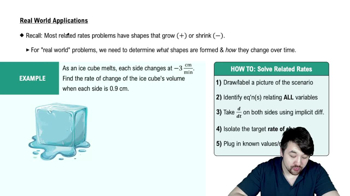Table of contents
- 0. Functions7h 52m
- Introduction to Functions16m
- Piecewise Functions10m
- Properties of Functions9m
- Common Functions1h 8m
- Transformations5m
- Combining Functions27m
- Exponent rules32m
- Exponential Functions28m
- Logarithmic Functions24m
- Properties of Logarithms34m
- Exponential & Logarithmic Equations35m
- Introduction to Trigonometric Functions38m
- Graphs of Trigonometric Functions44m
- Trigonometric Identities47m
- Inverse Trigonometric Functions48m
- 1. Limits and Continuity2h 2m
- 2. Intro to Derivatives1h 33m
- 3. Techniques of Differentiation3h 18m
- 4. Applications of Derivatives2h 38m
- 5. Graphical Applications of Derivatives6h 2m
- 6. Derivatives of Inverse, Exponential, & Logarithmic Functions2h 37m
- 7. Antiderivatives & Indefinite Integrals1h 26m
- 8. Definite Integrals4h 44m
- 9. Graphical Applications of Integrals2h 27m
- 10. Physics Applications of Integrals 2h 22m
4. Applications of Derivatives
Related Rates
Problem 3.7.105b
Textbook Question
{Use of Tech} Power and energy The total energy in megawatt-hr (MWh) used by a town is given by E(t) = 400t+2400/π sin πt/12, where t≥0 is measured in hours, with t=0 corresponding to noon.
b. At what time of day is the rate of energy consumption a maximum? What is the power at that time of day?
 Verified step by step guidance
Verified step by step guidance1
Step 1: To find the time of day when the rate of energy consumption is a maximum, we need to find the derivative of the energy function E(t) with respect to time t. This derivative, E'(t), represents the rate of energy consumption, also known as power.
Step 2: Differentiate E(t) = 400t + \frac{2400}{\pi} \sin\left(\frac{\pi t}{12}\right) with respect to t. Use the derivative rules: the derivative of 400t is 400, and for the sine term, use the chain rule. The derivative of \sin\left(\frac{\pi t}{12}\right) is \cos\left(\frac{\pi t}{12}\right) \cdot \frac{\pi}{12}.
Step 3: Set the derivative E'(t) equal to zero to find the critical points. This will help us determine when the rate of energy consumption is at a maximum or minimum. Solve the equation 400 + \frac{2400}{\pi} \cdot \cos\left(\frac{\pi t}{12}\right) \cdot \frac{\pi}{12} = 0 for t.
Step 4: Solve the equation from Step 3 for t to find the critical points. This involves isolating the cosine term and using inverse trigonometric functions to find the values of t that satisfy the equation.
Step 5: Evaluate the second derivative, E''(t), to determine the concavity at the critical points found in Step 4. If E''(t) is negative at a critical point, it indicates a local maximum. Use this information to identify the time of day when the rate of energy consumption is a maximum.
 Verified video answer for a similar problem:
Verified video answer for a similar problem:This video solution was recommended by our tutors as helpful for the problem above
Video duration:
8mPlay a video:
Was this helpful?
Key Concepts
Here are the essential concepts you must grasp in order to answer the question correctly.
Energy Function
The energy function E(t) represents the total energy consumed over time, where E(t) = 400t + (2400/π) sin(πt/12). Understanding this function is crucial as it describes how energy consumption varies with time, allowing us to analyze its behavior and derive important characteristics such as maximum consumption.
Recommended video:

Properties of Functions
Rate of Change
The rate of energy consumption is determined by the derivative of the energy function, E'(t). This derivative indicates how quickly energy is being consumed at any given time, and finding its maximum value will help identify when the energy consumption is at its peak.
Recommended video:

Intro To Related Rates
Critical Points
Critical points occur where the derivative E'(t) is zero or undefined. These points are essential for determining local maxima or minima in the energy consumption function. By analyzing these points, we can find the specific time of day when the rate of energy consumption reaches its maximum.
Recommended video:

Critical Points
Related Videos
Related Practice





